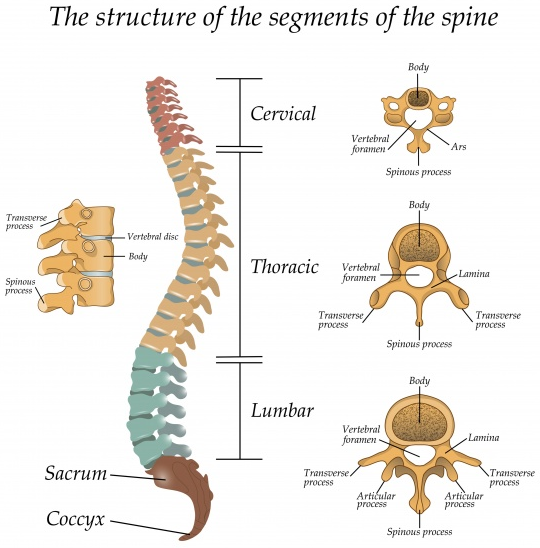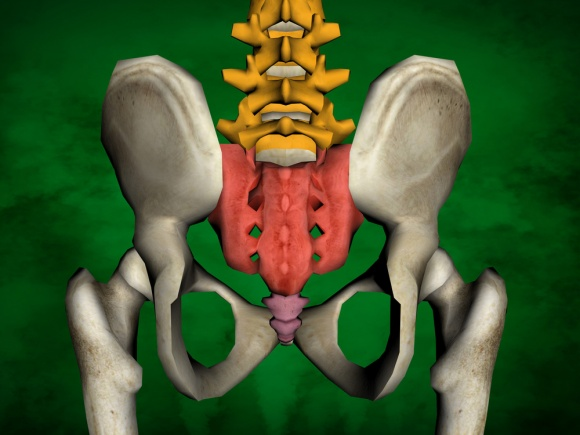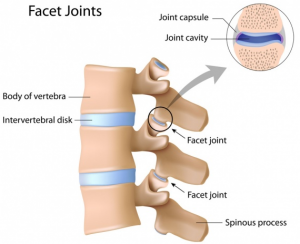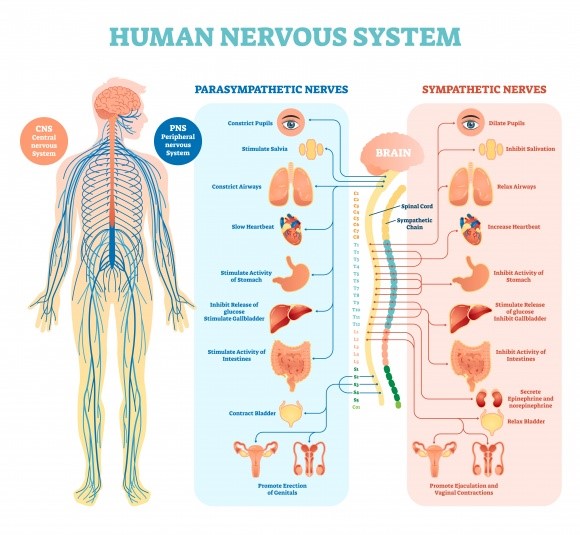The spinal column (vertebral column or backbone) provides both structural and nervous system support for your entire body. Made up of 34 bones, the spinal column holds the body upright, allows it to bend and twist with ease and provides a conduit for major nerves running from the brain to the tips of the toes—and everywhere in between.

SPINAL COLUMN’S SCAFFOLD OF BONE
The entire spinal column consists of 24 individual bones called vertebrae, plus 2 sections of naturally fused vertebrae—the sacrum and the coccyx—located at the very bottom of the spine. When most people talk about the spinal column, they’re actually referring to the vertebral column: the 24 circular vertebrae that march down the middle of the back.
The vertebral column can be divided into 5 regions:
- Cervical spine: 7 vertebrae of the neck (C1-C7)
- C1 is the atlas
- C2 is the axis
- Thoracic spine: 12 vertebrae of the mid-back (T1-T12)
- Lumbar spine: 5 vertebrae of the lower back (L1-L5)
- Sacrum
- Coccyx
A normal vertebral column creates a graceful, double-S curve when viewed from the side of the body. The cervical vertebrae gently curve inward, while the thoracic spine curves gently outward, followed by the lumbar spine, which curves inward again. This structure gives the spinal column great strength and shock-absorbing qualities.
Sacrum and Coccyx
The sacrum (or sacral spine) is a triangular-shaped bone located below the last lumbar spinal vertebrae. The sacrum sits between the hip bones (called iliac bones) and forms the back of the pelvis. The sacrum connects to the pelvis at the left and right sides by the sacroiliac joints (SI joints).
Immediately below the sacrum are 3 to 5 small bones that naturally fuse together at adulthood forming the coccyx or tailbone. Sometimes the coccyx is termed the coccygeal vertebrae. Although the tailbone is very small and may seem insignificant, it plays an important role in supporting your weight when you sit.

Spine Movement Enablers and Stabilizers: Discs, Facet Joints, Ligaments, Muscles
The spinal column doesn’t consist only of bones. To maintain its double-S shape, provide skeletal support and route the nerves where they need to go, the spine also relies on a number of supporting structures.
First among these structures are the spinal discs, called intervertebral discs. Each disc is similar to a fibrous pad of tissue (called fibrocartilage) and anchored in place by vertebral endplates (called cartilaginous endplates) starting at C3 through L5-sacrum. These discs act as interbody spacers and shock absorbers. Notably, there is no spinal disc between C1 and C2, nor is there a disc between the sacrum and the coccyx.
Facet joints are paired (left, right sides) at the back of each vertebral body (C3-L5). Sometimes these joints are called zygapophyseal or apophyseal joints. These joints help stabilize the spine while allowing flexion (bending forward), extension (bending backward) and twisting movement (called articulation). Similar to other joints in the body, each facet joint is encased in a capsule of connective tissue that produces a nourishing fluid that lubricates the joint. Cartilage coats the joint surfaces ensuring smooth movement.
 Different types of spinal ligaments—strong, tough, bands of tissue—connect the vertebrae, discs and facet joints to help stabilize and support the spinal column at rest and during movement. The ligaments act like stretchy-like tension cords that allow the spine’s bones, discs and joints (facet joints) to move within a limited range.
Different types of spinal ligaments—strong, tough, bands of tissue—connect the vertebrae, discs and facet joints to help stabilize and support the spinal column at rest and during movement. The ligaments act like stretchy-like tension cords that allow the spine’s bones, discs and joints (facet joints) to move within a limited range.
And, of course, small and large spinal muscles and tendons help stabilize and strengthen the vertebral column while supporting and limiting extreme bending, flexing and twisting movements.
Vertebral Column Protects the Spinal Nerves
The vertebral column serves to protect the spinal cord and nerve roots, which are part of the central nervous system that starts at the base of the brain. The vertebral structures form a continuous round hollow space that houses the spinal cord from the cervical through lumbar spine.
Small nerve roots branch off from the spinal cord and exit the vertebral column through foramen, also called foramina or neuroforamen. Each foraminal space is created on the left and right sides of an intervertebral disc, which is anchored between 2 vertebral bodies. After the nerve root exits the spinal column, it branches out into the peripheral nervous system—that serves the entire body head to toe.
Near L1 and the sacrum, the spinal cord ends and becomes a fanlike wisp of nerves called the cauda equina resembling a horse’s tail.
Vertebral Column and Spinal Nerves
If you envision the spinal canal as an interstate highway, you can imagine the foramen as highway exits. Each set of spinal nerves exit the spinal canal through the foramina associated with a particular part of the body that nerve system supports—nerves enable the function (motor) and feeling (sensation). For example, the nerves that provide sensation to the fingers exit the spinal canal via foramina in the cervical spine—because that segment is located nearest the hands.
Spine specialists have a deep understanding of the nervous system, including cause and effect of spinal disorders. The patient’s description of their symptoms coupled with a physical and neurological examination help the spine doctor diagnose the problem (eg, sciatica) and its cause (eg, herniated disc).
Listed below are parts of the body associated with regions of the spinal column:
- Cervical spine: diaphragm (breathing), shoulders, parts of the arms, esophagus, part of the chest
- Thoracic spine: parts of the arm and esophagus, trachea, heart, lungs, liver, gallbladder, small intestine
- Lumbar spine: legs and feet
- Sacrum: bowel, bladder, sexual function








